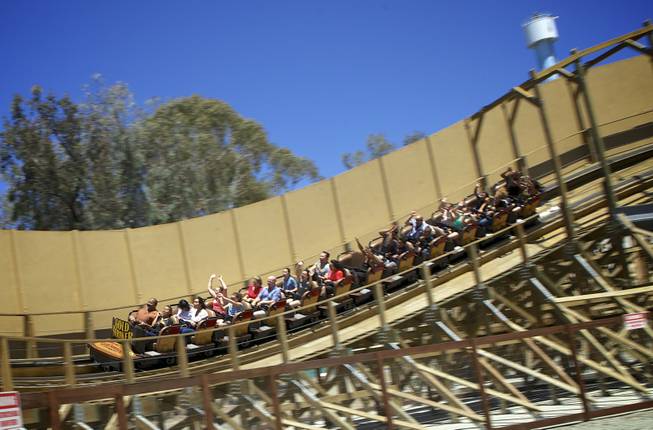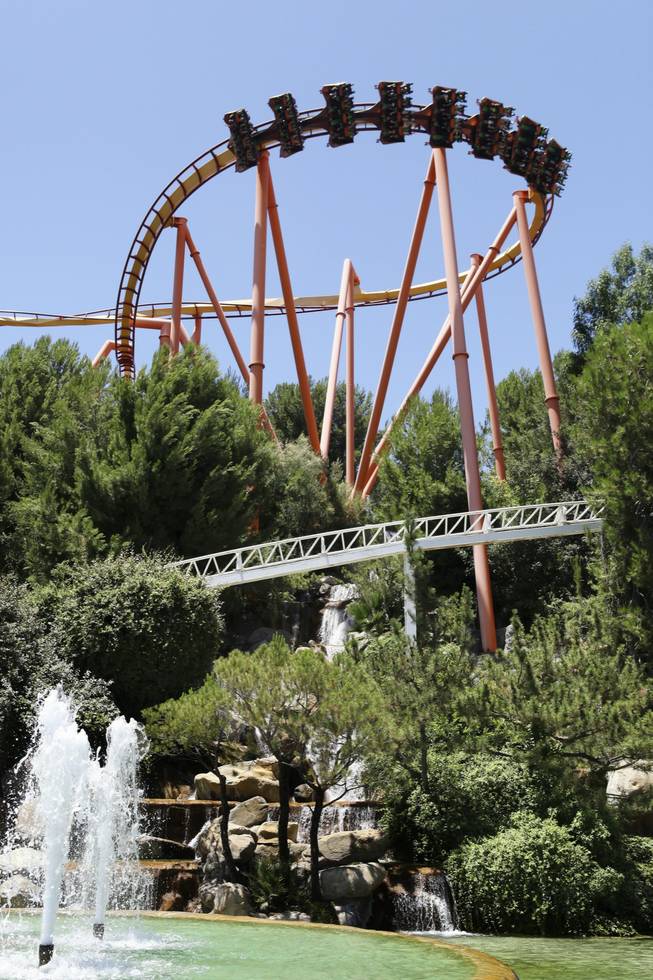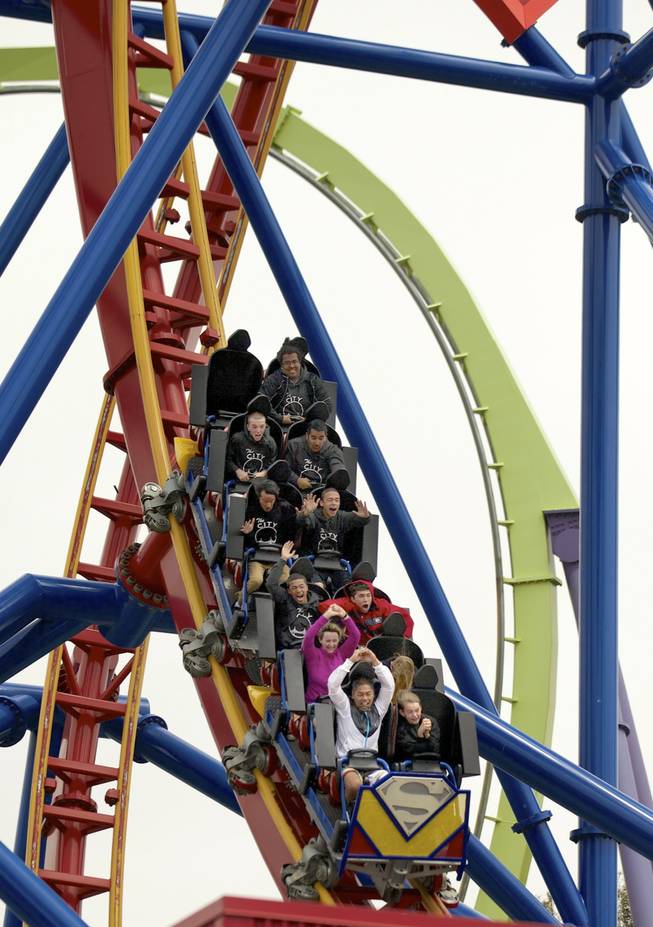
Thor Swift / The New York Times
Riders on the Gold Striker roller coaster at California’s Great America in Santa Clara, Calif., July 13, 2013. In one topsy-turvy, dizzying trip from the Bay Area to Los Angeles, Mekado Murphy recently rode 40 roller coasters in eight parks across California.
Saturday, Aug. 10, 2013 | 2 a.m.
There are people who go to amusement parks for the rides, for the nostalgia, for the cotton candy and, of course, to placate their children.
Then there are people like me who buy a ticket with a singular purpose: to take as many roller coaster rides as humanly possible. I recently stretched this exercise out a full week during a visit to California, which, according to the Roller Coaster DataBase, has more than 80 operating coasters, the most in the nation.
In one topsy-turvy, dizzying trip from the Bay Area to Los Angeles, I rode 40 roller coasters in eight parks. Taking breaks only to fuel up on turkey legs, funnel cakes and Dippin’ Dots ice cream, I tried out the newest rides (Full Throttle at Magic Mountain and Gold Striker at California’s Great America) and the oldest (Giant Dipper at Santa Cruz Beach Boardwalk). I rode most every kind of coaster, from the inverted kind, where you dangle from the track above you (Silver Bullet at Knott’s Berry Farm) to indoor coasters that work narratives into the ride (Revenge of the Mummy at Universal Studios Hollywood). Using many of the parks’ single rider lines (which cut down the wait time significantly), I managed to go on the best coasters more than once and to shuttle swiftly from one ride to the next.
Following is a look at five of the most intriguing coasters I came across on my journey. Many are clustered in behemoth chains (like Six Flags, which in my experience places an emphasis on safety despite a fatal accident last month in Texas). Each represents a different style and should not be missed when considering your own marathon coaster tour through the state.
-
The Giant Dipper, Santa Cruz Beach Boardwalk
Top speed: 46 mph
Standout feature: The starting tunnel
Sometimes an oldie truly is a goody. And the Santa Cruz Beach Boardwalk boasts one of the best of the classics: the Giant Dipper, which has been thrilling riders since 1924. It is the fifth-oldest coaster in the United States, has been declared a national historic landmark and is the focal point of a long, active boardwalk. Its white structure and red track soar to the skyline, providing views of Monterey Bay from the top of its lift hill. Like many boardwalk rides, this one can be paid for à la carte; it is not part of a park that has a flat-rate admission.
One of the most exciting aspects of the ride is the way it starts. Just after leaving the station, it enters a pitch-black tunnel and twists and turns even before getting to the lift. After the first drop is an immediate hard turn that leads to a couple of hills before another turn and a set of bouncy hills. If you like the wind through your hair and your stomach in your throat, Giant Dipper is a fairly no-frills path to a feverish amount of air time, that feeling of weightlessness that coaster lovers crave.
Tickets: $6 (six tickets at $1 each); website here.
-
Tatsu, Six Flags Magic Mountain, Valencia
Top speed: 62 mph
Standout feature: The pretzel loop
A coaster that simulates the feeling of flying, birdlike, through the sky is difficult to get right. You need restraints that don’t feel too restrictive or uncomfortable, and you need enough height and speed to feel you’re truly going places. Tatsu, the most breathtaking example of this type of coaster, rests along hilly, wooded terrain at Six Flags Magic Mountain in Valencia.
The ride is designed by Bolliger & Mabillard, a Swiss engineering company behind a number of flying coasters around the country. These coasters send riders soaring on their stomachs suspended from a winding steel track. But Tatsu is the tallest and most majestic of the bunch. And because it is positioned along a particularly mountainous portion of the park and moves through four different areas of varying heights, the riders’ perspective is continually changing. The lift hill, which gives a direct view of the ground below, climbs to 170 feet, yet it feels much higher as you see the people walking though the park getting smaller and smaller. The ride reaches a speed of 62 mph as it moves through four different inversions.
The one truly unforgettable element is a 124-foot “pretzel loop,” which has tracks overlapping at the entry and exit points. It puts riders upside down and forces them to spend a few moments on their backs with extreme positive G-force pressure before emerging into the rest of the ride.
Online tickets: $46.99; Gate: $66.99; website here.
-
Gold Striker, California’s Great America, Santa Clara
Top speed: 54 mph
Standout feature: The Mine Shaft
Wooden roller coasters, known among coaster fans as “woodies,” have remained tremendously popular, even as innovative steel rides armed with the latest technology steal their thunder. Still, some parks invest in new woodies, where the suspense doesn’t come from wondering whether the rickety rails will survive the ride.
Great America in Santa Clara decided to go the woodie route with Gold Striker, which opened this year. The look of it from afar is a sight to behold: 700,000 square feet of fresh Southern yellow pine. But the ride has the swiftness and hairpin turns of a steelie. Unlike Giant Dipper, the Gold Striker relies on sharp curves — like an 85-degree bank at one point — rather than bouncy hills.
It starts off with a bang: There is a 103-foot first drop that goes through a tunnel, which the park calls the “Mine Shaft.” (That is the tallest descent within a tunnel on a wooden coaster in the world.) Then the track makes a quick turn and races along above the ride queue, allowing those in line to feel the reverberations of the track as they wait. I rode the coaster within a month of its opening, a considerable bonus because there had been little time for the wood to shift around and for the ride to become bumpy.
Online tickets: $45.99; Gate: $62.99; website here.
-
Superman: Ultimate Flight — Six Flags Discovery Kingdom, Vallejo
Top speed: 63 mph
Standout feature: Noninverting loop
This mini-thriller of a coaster comes from Premier Rides, a Baltimore-based manufacturer that has specialized in launch coasters, which forgo a traditional lift hill in exchange for shooting its riders out the station without much warning.
From the ground, the track just looks like a big oval and a smaller circle, a simple design that ends up eliciting a complicated combination of elation and fear. Using electromagnetic propulsion, the coaster launches riders out of the station and slightly up a vertical twisty track. After losing momentum, the coaster reverses along that track, going through the station again and continues backward up the other side of the track. Again, momentum lost, the coaster zooms forward, going through the station a third time and climbs 150 feet vertically. At that height, the track then twists into a 360-degree roll before plunging downward and taking you through a small loop. So basically, it’s insanity.
Superman is loaded with air time, and one of its most exciting elements is that final, compact noninverting loop, which means you complete a full loop but the track twists so that you don’t go upside down — you’re atop it at the highest point. The experience is exhilarating. While Ultimate Flight suffered some bad press last summer after a group of riders was stranded on the track, I rode the coaster multiple times with no problems.
Online tickets: $51.99; Gate: $61.99; website here.
-
Green Lantern: First Flight — Six Flags Magic Mountain, Valencia
Top speed: 35 mph
Standout feature: Seats that spin 360 degrees
In all its emerald, snaky-looking glory, Green Lantern: First Flight is one of the most original roller coasters that California has to offer. And while it might not seem so at first glance — don’t let the slow speed fool you — it is also one of the scariest. This ride fits into the category of “fourth dimension coasters,” where riders’ seats pivot and turn independently of the direction of the track, creating a thrilling, if sometimes disorienting, journey. The park has one other fourth dimension ride, X², but the more straightforward course that the Green Lantern takes makes for a better experience.
Each car on this coaster, so to speak, has four seats on each side of the track but no floor. The seats spin around forward and backward while the cars lunge through the breathtaking course and your feet dangle in the air. One person near me described the sensation as “life and death.” The descent happens in segments: The track is level then drops off, plunging down to the next level section. With each drop, the screams get louder and the intensity doesn’t let up. The final time I rode it, my last drop into the station ended with me and the other riders in my car upside down. It’s both frightening and sensational all at once.
Online tickets: $46.99; Gate: $66.99; website here.





Join the Discussion:
Check this out for a full explanation of our conversion to the LiveFyre commenting system and instructions on how to sign up for an account.
Full comments policy